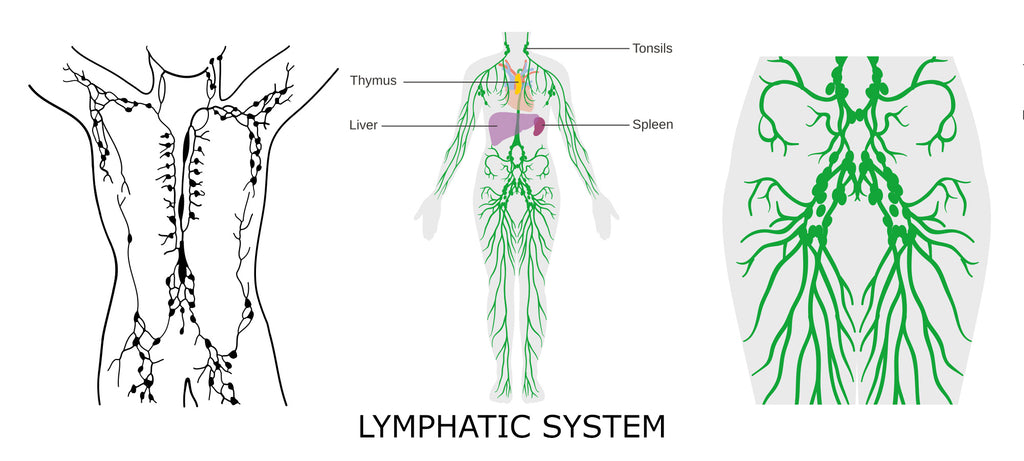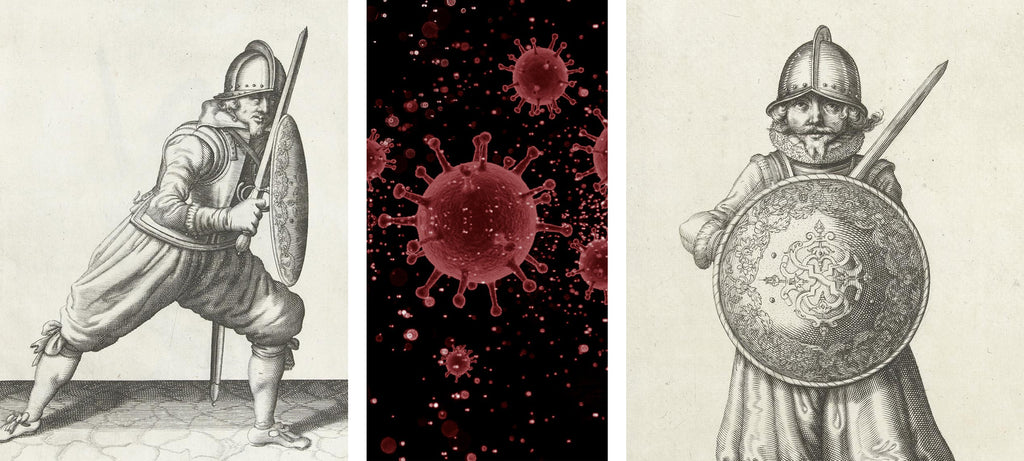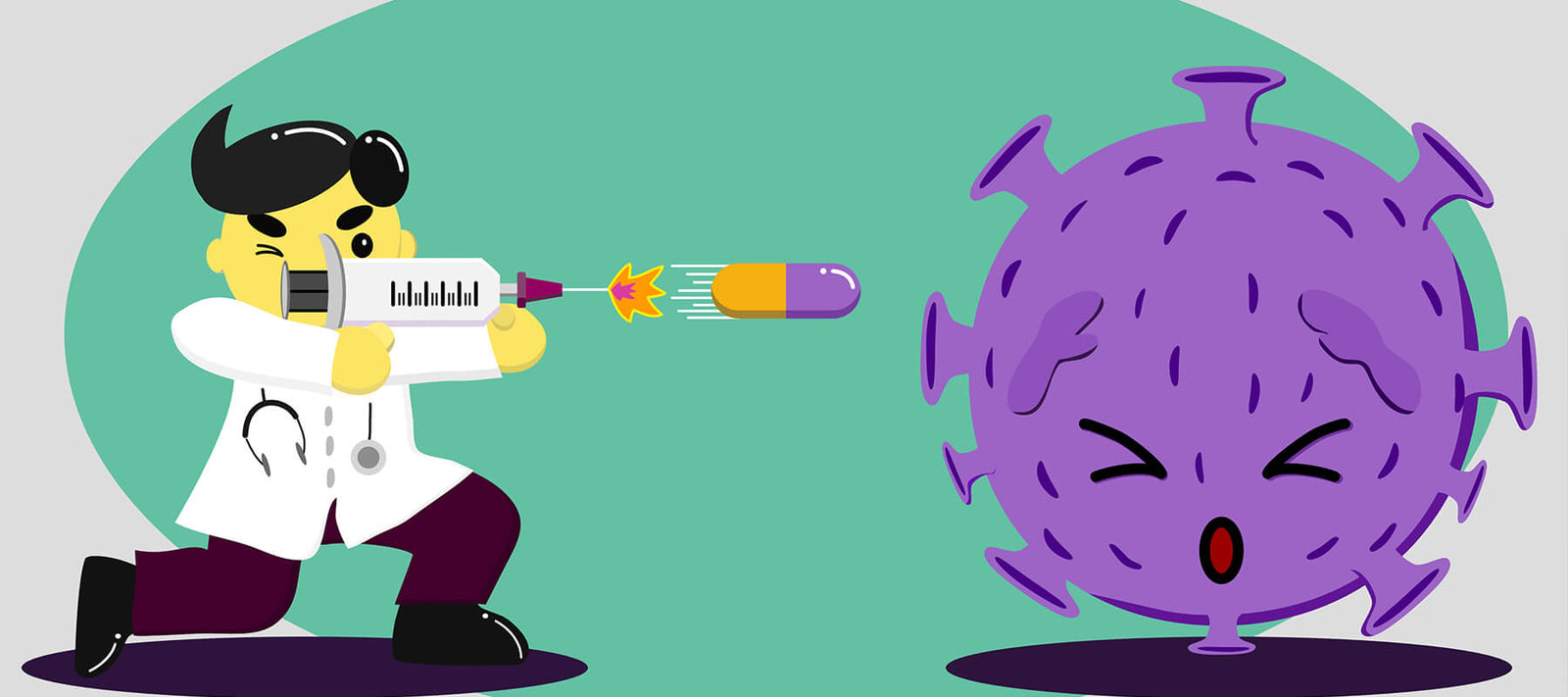Our immune system is a network of cells, organs, proteins and tissues that has evolved over the ages to combat infection and disease.
One of its most powerful capabilities is to tell "self" from "non-self," that is to say: it can recognise invaders from outside such as bacteria, viruses, fungi, and other pathogens (disease-causing organisms).
It's so effective that most people tend to take it for granted. We start paying attention to it only when it goes wrong – as it does with autoimmune disorders – or when it gets overloaded by the emergence of a previously unencountered invader (such as the coronavirus which causes COVID-19).
So how does the immune system work and what can we do to ensure that it works for us in these challenging times?
How the Immune System Works
Imagine the human body as a medieval castle with a magnificent array of defences: an outer bailey, a moat, an inner keep, and soldiers with a variety of weapons – bows and arrows, slingshots and swords. Every weapon meets a specific need, from the first line of defence to the last.

The body's first line of defence is the skin. If the skin is intact it's actually very difficult for pathogens to gain entry to the body's interior, let alone any vital organs. Yes, there are weak points: eyes, nose, mouth, and any breaks in the skin. But even here there are strong defences, courtesy of the immune system.
For example, when a pathogen enters the nose it often provokes a sneeze. This is because the immune system detects the invader, triggering a release of mucus which contains antibodies to kill the germs and thus keeping the upper respiratory tract healthy.
To help the process there are microscopic hairs in the airways that are able move mucus up from the lungs and into the nose or mouth where the pathogens can be expelled.
These are just two examples of basic immunity protection just beyond the outer barrier of the skin. Another is our stomach acid which kills off any pathogens we may have swallowed with our food.
Powerful antibodies (specifically the immunoglobulin IgA) exist in tears and saliva, ready to defend "the castle" – the human body – at two of its most vulnerable entrances.
Varying Levels of Threat
An individual illness, such as a common cold, can vary greatly in strength, from mild to severe. Although this may be because of the particular strain of the bacterium or virus, the "dosage" of the pathogen is also critical. A large dose can lead to a more severe illness. Even so, a pathogen may survive the first lines of defence, but it needs to pass many of the immune system's other defences before it can do real damage.
For example, throughout the body, beyond the passageways of our digestive and respiratory systems there are small entities called macrophages that patrol for invaders and digest them rapidly.
Alas, such is the ferocity of attacks from outside forces, from time to time an invading bacterium or virus breaks through and starts to multiply. It takes over cells, reduces the functioning of important organs, and causes illness.
A Special Case
The SARS-CoV-2 virus that causes COVID-19 is particularly invasive – and its protein spike is 10-20 times more likely than those of previous coronviruses (including SARS 2002) to attach to human cells.

Fortunately the majority of those infected recover quickly because the immune system is well-organised and (if it's in good working order) able to deal with the most virulent of pathogens, even those it has never encountered before.
How the Immune System is Organised
At first sight, the immune system appears to be scattered in a haphazard way around the body, with clusters of activity taking place in the spleen – where blood is filtered – as well as in the digestive tract, the lungs and airways, and in places such as the tonsils and even the appendix.
However, efficient communication takes place between the various parts of this distributed system, especially along the lymphatic system: a network of vessels running near the arteries and veins of the bloodstream. At many points in this network are the lymph nodes – small, bean-shaped glands clustered in the neck, armpits, abdomen, and groin.

Lymph (so-called because the "Lympha" is the ancient Roman deity of fresh water) is a watery, milk-coloured fluid derived from the "interstitial fluid" found between body tissues. Blood vessels are constantly releasing plasma into the body, then reabsorbing most of it but leaving a surplus (about 3 litres a day) which is taken up by the lymphatic vessels and delivered to the lymphatic nodes.
There, in the nodes, it renews and improves one of the main components of the immune system's weaponry: lymphocytes.
Preparing for Battle
Lymphocytes are small white blood cells, which, like all blood cells, come originally from bone marrow. While some lymphocytes remain in the marrow to become "B lymphocytes" (B cells) others go to the thymus – a gland located below the neck in between the lungs – where they become T lymphocytes (T cells).
These two broad types of lymphocyte have different functions. While they're both on the lookout for antigens – the "ANTIbody GENeratorS" (those parts of a pathogen that alert the body to an infection) – the B lymphocytes secrete antibodies to lock onto the antigens, setting them up to be recognised and dealt with by the T cells.
A virus may have only three or four antigens, although others, such as the herpes virus, has over a 100. Bacteria and fungi, on the other hand, can have several hundreds or even thousands of antigens.
The B cells have to produce a specific antibody to fit each invader, similar to the way in which a carpenter might assemble a tool to fit a specific job. There is no "one-size fits all" in the immune business. Bacteria and viruses come in all shapes and sizes.
Well-developed immune systems are likely to have had previous encounters with a given antigen. Hence, for most of the time, many of the tools are already in the library of "immune memories." If not, the system has to work harder to make the right tools from basic, low-level building blocks.
Bring Out the Tough Guys
In the final battle with the invading organisms, it's the T lymphocytes who get the privilege of dispatching the enemy. There are two types: the Helper T's and the Killer T's, and they – together with a third assassin called Natural Killer (NK) cells – are powerful agents to fight on our behalf.
The Helper T cells are the ones that organise the response by communicating with other cells, getting B cells to make more antibodies if necessary and calling up additional T cells to boost the fightback.
The Killer T cells are especially good at killing viruses, which are much smaller than bacteria and embed themselves inside human cells. Killer cells can recognise the tiny parts of a virus that stick out of the cell, alerting them to destroy the cell and the virus along with it.
Viruses pose a dangerous threat to the immune system because of this ability to hide themselves inside human cells where the most numerous defences (such as the macrophages) cannot recognise them.
Killer T cells are "cytotoxic," which means they have permission to kill cells within the body, providing they've been marked for destruction by the Helper Ts.

The Natural Killer (NK) cells, unlike the Killer T's, have an even more powerful "licence to kill," being permitted to destroy antigens that are not being carried by one of the body's own protein molecules. They fire chemical granules at the invader to destroy it.
Clean-Up Time
As you can imagine, the immune system needs to clean up constantly until it can restore the body to normality. It does this by removing dead cells and foreign matter, passing the detritus through the lymph nodes.
The lymph flows through a succession of lymphatic vessels that get progressively larger, finally to rejoin the blood stream at one of the two "subclavian veins" near the collar bone. By this time the lymph has been thoroughly filtered and renewed with replacement lymphocytes.
How Can We Protect the Immune System?
Protecting our immune systems is key to human survival, especially with the onslaught of new coronaviruses and influenza strains.
Vaccination, against diseases like measles and rubella which can seriously damage our immune system, is especially important.

The best way to protect the immune system is to start paying attention to it rather than taking it for granted.
For a start, this means eating a balanced diet – but not in quantities greater than you need for the amount of energy you expend – keeping fit, and getting a good night's sleep.
Keeping fit is particularly important because the circulating lymph is not pumped, unlike the bloodstream, but flows passively into the lymphatic vessels where its movement is aided by body movements and deep breathing.
Inadequate SLEEP (less than 5 hours instead of 7-8 hours) has been shown to have a detrimental effect on the immune system while also increasing the risk of heart disease and obesity: conditions that increase people's vulnerability to infection.

Why Good Decisions Matter
Although the body's first line of defence is the skin, there is another, even more important entity: the human brain. It's the individual brain that can do most to keep the body – and hence the immune system – safe and healthy by making good decisions based on accurately reported scientific evidence.

Protecting the immune system therefore means avoiding, wherever possible, anything that can damage or overload it. These include the following:
* too much alcohol * recreational drug use * poor nutrition * lack of exercise * viral infections * unnecessary antibiotics
To check that you're eating a balanced diet, make sure it contains foods that boost your immunity.
In particular, it should include food that enables the production of white blood cells – which, in turn, carry the all-important lymphocytes for generating antibodies.
Food Sources to Boost Immunity
These are all good sources of nutrients for supporting the production of white blood cells and general immunity:
- Vitamin A is specially important for increasing lymphocytes (source: green, leafy vegetables)
- Vitamin C is a must-have vitamin for boosting overall immunity (source: citrus fruits)
- Vitamin D is essential, but often lacking when we stay indoors (source: sunlight)
- Vitamin E helps to create additional natural killer cells (source: seeds and nuts, avocados, spinach)
- Garlic (source: garlic cloves, or, in concentrated form, as a supplement)
- Omega-3 fatty acids help to increase the action of immune cells (source: fish oil, brussels sprouts, chia seeds)
- Probiotics (source: active yogurts)
- Selenium (source: brazil nuts, oysters, tuna, poultry)
- Zinc (source: whole grains, shellfish, esp. oysters, poultry)
Supplement Sources to Boost Immunity
In the wake of the COVID-19 pandemic, manufacturers offer many health supplements to boost immunity. Although these products won't cure an infection they do help to make up for any deficiencies in your diet.
Some supplements go even further in providing some unique benefits to the immune system in fighting viruses. Two of these are:
- Elderberry According to a 2019 study at the University of Sydney, phytochemicals in elderberries can halt the invasion of cells by certain flu viruses and slow the rate of propagation within cells already infected. See Lifeteropics Elderberry Complex
- Echinacea A study conducted at the Common Cold Centre in Cardiff University in 2012 showed that Echinacea reduced the duration of the common cold in a significant number of the participants.
Summary
It is inevitable that there will be further waves of viruses spreading across the globe. For that reason alone – quite apart from the additional threats of bacteria and other organisms – we need to consider and protect our immune systems as a priority: with a good DIET, sufficient EXERCISE, restful SLEEP, intelligent AVOIDANCE of infection, and yes, extra vitamins and other SUPPLEMENTS where necessary.
About the author: John Lewell has writen feature articles on science and technology for New Scientist and around 50 other publications. A graduate of Peterhouse, Cambridge, he is the author of five books and two e-books.









Leave a comment (all fields required)